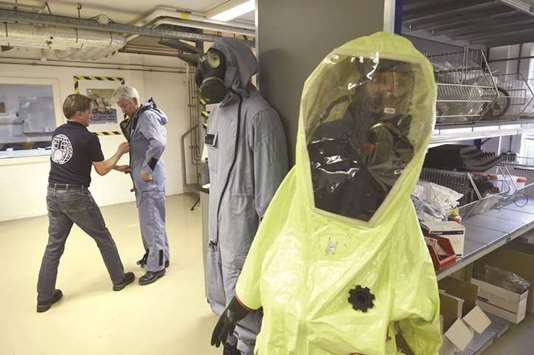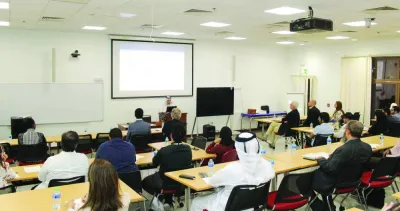Michael Barrett has an old-fashioned flip phone.
But when his hotline rings, he has three hours to ready equipment for experts on a dangerous mission to probe if toxic weapons have been unleashed — again.
As appalling images of panicked children and adults apparently victims of poison gas or cruel nerve agents go viral, the labs and the equipment store of the world’s global chemical arms watchdog hum with activity.
Tucked away in a small industrial zone in the Dutch suburb of Rijswijk, the two-storey building, with about 20 staff, has been key to the two decades of painstaking work by the Organisation for the Prohibition of Chemical Weapons (OPCW) to eliminate the world’s toxic arms stockpiles.
It was here that the team, now in Syria waiting for access to Douma where either chlorine or sarin gas were allegedly used on civilians on April 7, began their mission.
As the clamour grows for answers, any samples they collect will be sealed and brought back here, under a strictly monitored chain of custody, for further analysis and verification.
A former soldier, Barrett has spent 21 years at the OPCW since its first beginnings, training and equipping those who volunteer to travel to the world’s most toxic hotspots.
He’s even deployed himself.
“Of course you get nervous, if you don’t there’s something wrong,” said the now 61-year-old, who in recent years has seen the timeline for preparing for missions getting “shorter and shorter.”
From carbon-impregnated protection suits to elephant-sized rubber boots to cover shoes, sophisticated detectors, satellite phones and medical kits bristling with vials of antidotes to the world’s deadliest nerve agents, all the equipment has to be checked and double-checked.
“Can you imagine if you had a respirator, a gas mask, and the valve was in the wrong way?” said Barrett wryly, principal logistics technician and team leader for the equipment store, as he gave AFP an exclusive tour.
Amid political claim and counter-claim about chemical weapons use in Syria, where chlorine gas and mustard gas have both been proven to have been used, as well as the unleashing of a rare nerve agent last month in the sleepy British town of Salisbury, the focus here remains on protecting the team and preserving the integrity of science. No detail can be overlooked. Even a pinprick hole in a glove could prove fatal if a deadly nerve agent seeped through the skin to attack a person’s nervous system.
VX, the deadliest nerve agent ever invented, can kill within 20 minutes.
Despite some 7,000 official missions — 10,000 if you count training missions — in 21 years, it is a source of pride that no team member has ever been affected by a chemical weapon.
This dangerous and methodical work by the OPCW, which has around 400 staff, has succeeded in eliminating some 96% of the world’s toxic arms stockpiles.
A feat which won it the Nobel Peace Prize in 2013.
OPCW director general Ahmet Uzumcu praised his staff then, saying they had “shouldered an onerous but noble task” working with “quiet determination to rid the world of these heinous weapons.”
“One of the most dangerous jobs in the OPCW is an analytical chemist, because they’ve got to take the sample,” said Barrett.
Many are scientists who before joining the OPCW may never even have used a gas mask.
Now they can be working in war zones.
And in 2012, a new piece of equipment was added to already heavy bags — body armour made of kevlar in case they come under fire.
Once on site, a team of experts which can vary between two to 25 members, scans the area with flame photometric detectors or ion mobility spectrometers to detect any toxic agents.
Paper tests, like litmus tests, can also warn of the presence of nerve or blister agents.
Working under tight time constraints, sometimes with less than 20 minutes, they gather environmental samples, such as plants or soil, or even rubber window seals which can hold evidence of any contamination for weeks.
Biomedical samples like blood and urine from alleged victims are also key, and in some cases tissue from the dead will also be taken. “We prefer to take samples from survivors, because those can be interviewed, they can tell their story, which can be fact-checked from others,” said Marc-Michael Blum, the head of the OPCW laboratory.
Blood samples are best, Blum says, revealing some nerve agents or blister agents like mustard leave little traces for weeks, even up to three months, hiding in people’s bodies.
“We are looking for specific biomarkers in blood. You don’t normally find an intact agent, but rather it has metabolised,” he explained. “Even weeks after exposure these markers are still there and you can find them.”

A man tries on an air permeable charcoal impregnated suit, combined with a respirator (or gas mask), rubber boots and three layers of gloves during a simulation at the OPCW headquarters in The Hague, The Netherlands.


